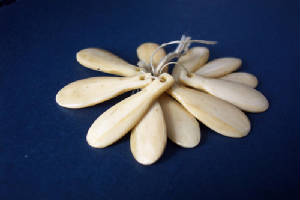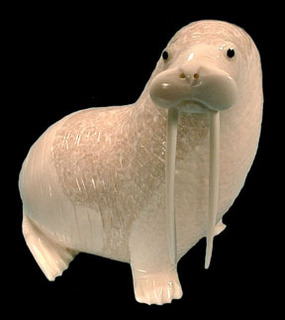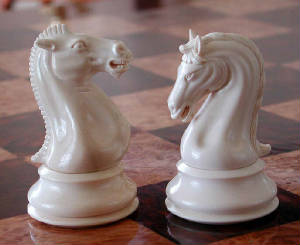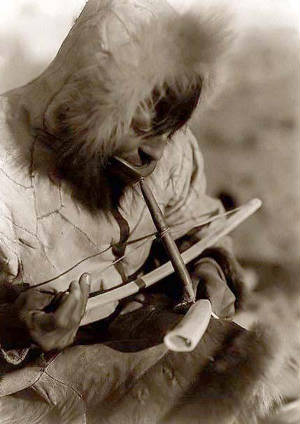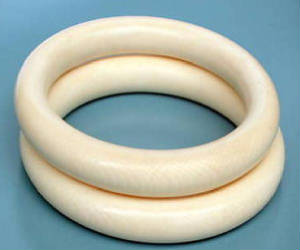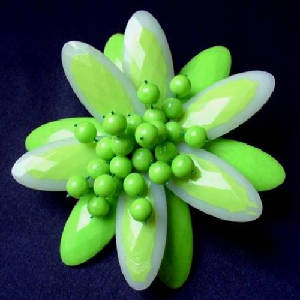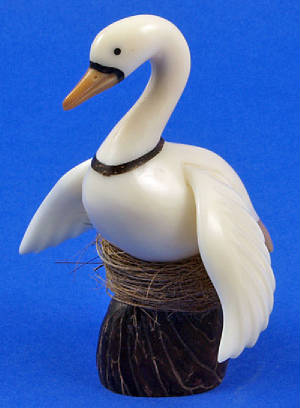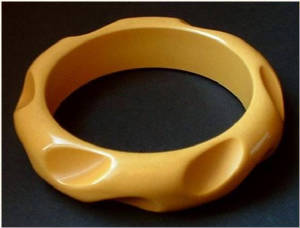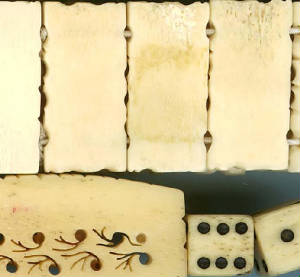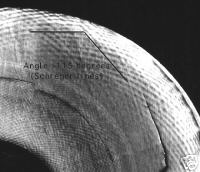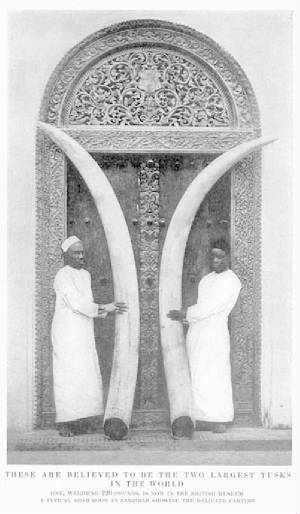|
What is Ivory?
Ivory is formed from dentine and constitutes the bulk of the teeth and tusks of animals. The word "ivory" was traditionally applied to the tusks of elephants; the word is ultimately from Ancient Egyptian âb, âbu "elephant". "True" ivory comes from elephants and mammoth; however, the term is generally applied to the tusks of other mammals, and some synthetics. Chemically, ivory is similar to bone and antler, and comprises a collagen matrix with a mineral component. Unlike bone, ivory has no blood vessel system, and is therefore more dense. The most commonly found ivories in North America come from elephant, walrus, sperm whale, and hornbill.
Different Kinds of Ivory
It is possible to tell these ivories apart, as they are structurally different. This category includes ivory from both Indian and African elephants, as well as ivory from mammoths and mastodon. The tusks, or upper incisors, of these animals are used. They can have a cross section of up to 20cm (8"), and be up to 2.5m (almost 3 yards) long. They are oval in cross section, and are made up of a hard, dense tissue called dentin, which is made up of 70% inorganic material, and 30% collagen.
1. Elephant Ivory
Unlike human teeth, elephant tusks do not have an enamel coating. They do have a cementum layer, however; ivory dealers refer to this as the "bark" or the "rind". Occasionally this layer is retained on a piece of worked ivory. One-third to one-half of an elephant tusk is hollow.Growth occurs as layer upon layer of calcified tissue is deposited on the interior of the tusk; you can see these concentric oval growth lines (called the Lines of Owen) in cross section. If you cut ivory lengthwise, these lines appear triangular. Fine and even near the hollow of the tusk (the pulp cavity), these lines become wavy and have milky areas between them as you get closer to the outside of the tusk.
Unique to elephant ivory are the Lines of Retzius. These fine intersecting lines are visible in cross section, and give an engine-turned effect (intersecting lines with a diamond shape between them).
Elephant Ivory is probably the most commonly used ivory in jewelry, both costume and fine. Its most distinctive feature, if it can be found, is crosshatching. A bangle bracelet will usually show crosshatching on at least two small sections, however, many pieces of elephant ivory will not show any crosshatching because of the angle of cut through the material, though you should be able to find some grain lines. Mammoth ivory is the only other ivory that shows the crosshatching
Generally, elephant ivory has a fine, even grain and is easily carved in all directions. It can be thinly cut (i.e. for piano keys), and can be more delicately carved than bone. This ivory is often painted or stained, dyed, and gilded. When cut, the pores of the ivory fill with an oily substance, which helps the ivory polish up nicely.
2. Hippopotamus Ivory
This is the second most commonly used ivory, after elephant ivory. Often used for flat items, such as buttons and inlays, it comes from the lower canines and incisors of hippos. The size varies, depending on the size of the animal.The lower canine is curved, and has a triangular cross section; the incisor is straighter, and has a circular cross section. Both have two layers of dentin: an outer, primary dentin, and an inner, secondary dentin. The innermost layer has a marbled appearance which differs by species, and can even appear to have a greenish cast. The pulp cavities of these teeth are fairly small. Unlike elephant ivory, hippo ivory does have a thick enamel coating.
Hippo ivory is denser than elephant ivory, harder to carve, and has a finer grain. There is none of the "engine turned" effect in cross section, rather, hippo ivory has concentric rings in cross section. Finally, hippo ivory is less prone to decay than elephant ivory.
3. Walrus Ivory
This ivory comes from the upper canines of walrus. It is oval in cross section, and can be over 2 feet in length. It has an inner dentin layer (which has a high mineral content; it forms as the tusk grows, and leaves a marbled look on finished objects), an outer dentin layer, and a smooth, dense cementum layer. Walrus ivory is used primarily for small objects.4. Sperm Whale Ivory
Thirty teeth of the sperm whale can be used for ivory. Each of these teeth, up to 8" long and 3" across, are hollow for the first half of their length. Sperm whale ivory is easily confused with walrus ivory, as both have two distinct layers. The inner layer of sperm whale ivory, however, is much larger. As well, in a longitudinal section, sperm whale dentin has yellow "globules" included in the marbilization.5. Hornbill Ivory
This comes from the casque or epithema of the Helmeted Hornbill, a bird native to the East Indies. It is distinguished from the rest of its family (the Bucerotidae) by having the front of its almost vertical and slightly convex epithema made of a solid mass of horn. This "horn" or "ivory" is quite hard and closely-textured. This substance is used to make small objects such as buckles and brooches, and is highly valued by the Chinese. In cross section, you can see a bright yellow interior with a scarlet rim.6. Vegetable Ivory
The source of vegetable ivory is the inner seed of the South American ivory palm, and is thus completely made of cellulose (rather than collagen). These seeds are the size and shape of a small hen's egg, are very hard, and are solid all the way through. Vegetable ivory is smooth, takes a good polish, easily absorbs dyes, and is relatively inexpensive. It is used for small items only, such as dice and buttons. Since about WWII, vegetable ivory has been largely replaced by plastics.7. Synthetic Ivories
Since 1865, when it was first invented by Alexander Parkes, celluloid has been used as an excellent ivory substitute. Casein has also been used. Names for these "faux ivories" include French Ivory, Ivoride, Genuine French Ivory, Ivorine, etc. Both grain patterns and the engine turned effect are added -- in general, the patterns of these are very regular in the fakes, and more irregular in the real thing. In instances of very good imitations (i.e. using celluloid), chemical tests are required to tell real ivory and the fakes apart.8. Mammoth Ivory
Elephant and Mammoth ivories are distinguished by a peculiar structure in the grain properly called Schreger lines, and referred to as cross-hatching, engine turned effect, or stacked chevrons. Whether this structure is seen depends upon the direction of cut of the elephant or mammoth ivory. Some ivories have a grain, best described as similar to tree rings in miniature. How, and where they appear on a piece of jewelry, depends upon the angle of the cut.
The Mammoth Ivory is excavated from the permafrost of the Siberian tundra, which the wooly mammoth inhabited for more than 160,000 years. During the last ice age, the mammoth went extinct as the direct result of rapidly plummeting temperatures that literally flash froze the entire population of Mammuthus primigenius. The dry, cold environment of Siberia combined with the massive sheets of ice from the ice age created the ideal environment for the preservation of Mammoth Ivory. The wooly Mammoth have been entombed under the Siberian permafrost ever since, waiting to be unearthed.
For more than 2,000 years, Mammoth Ivory has been traded and it remains a highly prized commodity across the world. While that demand for the Mammoth Ivory has always been higher than its supply, it skyrocketed in 1963 when the CITES agreement was enacted. This agreement banned all sales of new Elephant or Walrus Ivory, in an effort to protect the animals from extinction. As a result, Mammoth Ivory became the only type of animal-based ivory that is exempt from the international trade restrictions because it is considered to be a fossil. Over the past few years, the price of Mammoth Ivory has more than doubled, due largely to the unprecedented demand for luxury goods from such emerging countries as India and China. This trend is expected to continue.
How to Tell Real Ivory from Imitations
Imitations are usually made from resins. Sometimes these resins will be blended with the remnants of ivory or bone carvings ground up to a fine powder. There is also "french ivory", "celluloid", or "ivrine". This type of "man made" material looks like ivory with very nice grain. However, the grain is very wide and consistent (too consistent). This material was used mostly for dresser accessories such as brushes, combs, change boxes, letter openers, page turners, etc. Resin items will not have the weight of ivory. Ivory has a very heavy specific gravity compared to most materials.
Looking for "ivory grain" is not always dependable to tell "real ivory". Some ivories have little grain. There is Western Africa Ivory and Eastern Africa Ivory. The ivory from the eastern side of Africa is referred to as "soft ivory" which is duller and contains more moisture and stands changes in temperature better. The ivory from the western part of Africa is referred to as "hard ivory" which is glassy and translucent. The Japanese used a lot of the western ivory for their okimonos. Elephant ivory does not always have obvious grain. In many cases, ivory graining varies depend on how the ivory was cut and which section of the tusk it comes from. The tusk tip is most valued since large part of the tusk is acutally hollow. The tusk tip is more suitable for carving as it is solid, and the tip usually displays the most beautiful cross-hataching grainings.
Bone has tiny little channels where the blood vessels and nerves resided. You can often see these, either straight in (on the backside) looking like little pockmarks, or as lines at an angle almost perpendicular, ie "dots and dashes". It can be easy to see, but also sometimes is not apparent on the surface, however, if you put a light behind it (lay it on your scanner) you should detect the short little lines of the channels.
Availability
Owing to the rapid decline in the populations of the animals that produce it, the importation and sale of ivory in many countries is banned or severely restricted. Much of the decline in population is due to poachers during and before the 1980s. Since the worldwide ivory trade ban in 1989 there have been ups and downs in elephant populations, and ivory trade as bans have been placed and lifted. Many African countries including Zimbabwe, Namibia and Botswana claim that ivory trade is necessary—both to stimulate their economies and reduce elephant populations which are allegedly harming the environment. A 1999 study done by Oxford University found that less than one percent of the five-hundred million US dollars ivory sales generated ever reach Africans; most of it goes to middlemen and vendors. However, in 2002 the United Nations partially lifted the ban on ivory trade, allowing a few countries to export certain amounts of ivory. The effectiveness of the policy is in question, in light of the study preceding the ban, and an updated study would be needed to evaluate the current state of the ivory trade.
In 2007 eBay, under pressure from the International Fund for Animal Welfare, made the decision to ban all international sales of elephant ivory products. The IFAW found that up to 90% of the elephant ivory transactions on Ebay violated their own wildlife policies and could potentially be illegal. In October, 2008, eBay expanded the ban, disallowing any sales of ivory on eBay starting in 2009.
|
|
Cross Section of Elephant Tusk
Elephant Ivory and Mammoth Ivory share a unique grain pattern known as Schreger
Lines. These lines can help to identify if a piece is elephant or mammoth ivory. The test itself is actually only 100% accurate
when viewing a complete section of the tusk and using the measurements on the outermost section of the tusk. Perhaps the best
way to tell the difference is to know the sources you buy from and make sure that they know their sources. The whole tusks
travel the world accompanied by inspection certificates that certify the material and subsequent certificates are issued for
the final products carved from the tusks. Here are some pictures to help you identify your items. The Schreger lines
in Elephant Ivory form angles greater than 115 degrees. If you look at the section nearest the center, you will see that the
angle is much tighter than 115 degrees in this area.
Cross Section of a Mammoth Tusk
The Schreger lines in Mammoth Ivory are much tighter throughout and the angle is less than 90 degrees when the tusk is cut straight through. Unfortunately, if the tusk is cut at an angle, this will make the lines appear more like elephant ivory. If it is under 90 it is definitely Mammoth Ivory. If it is over 90, it could be either and you need to look for other signs that may help determine the age.
|
